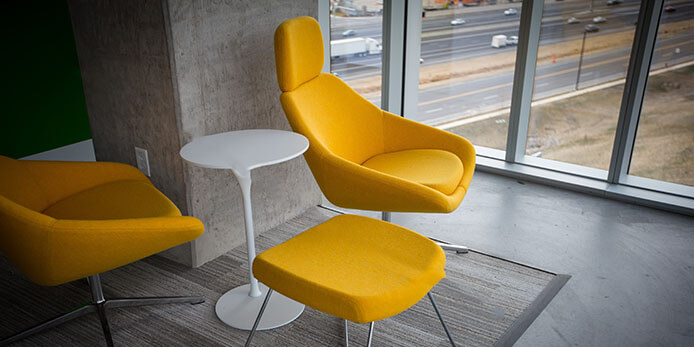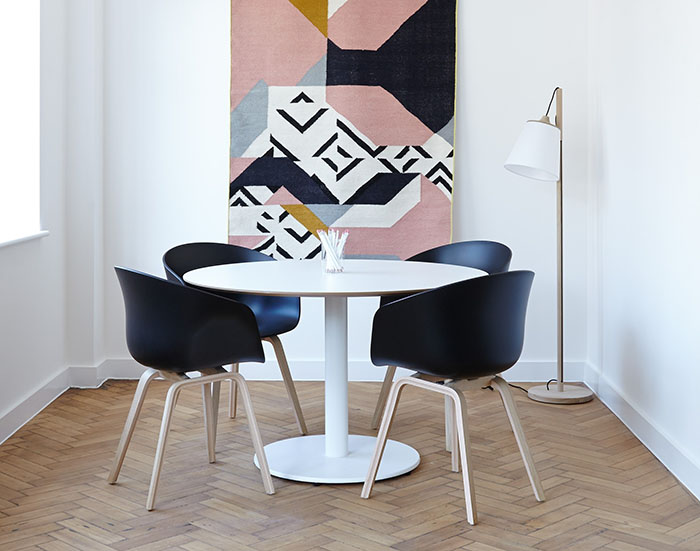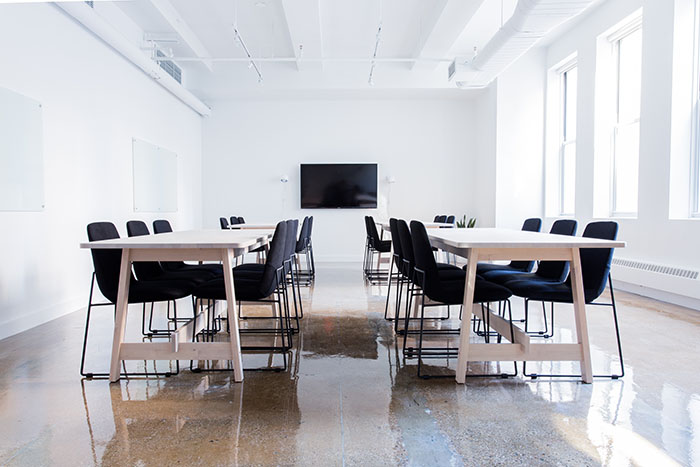
The huddle space has arrived as an important new type of meeting space in the modern workplace. These informal and inexpensive collaboration spaces are designed to maximize productivity with minimal infrastructure overhead costs. Here are four styles of huddle spaces you will see in companies that are embracing modern workplace design.
Crisp and Focused
Companies are scaling back on large conference rooms in favor of small, adaptable spaces that are designed to support a broad range of collaborative meetings. Many businesses seeking to benefit from such adaptable spaces are creating ‘baby boardrooms’. These are huddle rooms with traditional office furniture that are designed to hold fewer than 6 people. These rooms strike a balance between formal and collaborative and are usually fully enclosed. Common meeting types hosted in these rooms include scheduled small team meetings, interviews, and video conferences such as a kick-off with a vendor.

This style of huddle room provides privacy and must support both in-room collaboration as well as teleconferencing capabilities. With the rise of quick meetings, like daily stand-ups, meeting start-up time needs to be as instantaneous as possible. This poses a challenge for geographically diverse teams that must go through the hassle of setting up a special video and teleconference every day just to share a JIRA board with remote team members. By using Multi-Room alongside existing teleconferencing equipment, which could be as simple as someone’s smartphone on speaker, remote team members get the same on-screen experience as everyone else.
For companies and universities with campuses and/or global enterprise networks, Solstice Multi-Room drives better collaboration among internal teams spread across multiple locations.
Comfy and Casual
The quintessential huddle space is a cozy spot furnished with comfortable chairs and couches or even bean bags and exercise balls, designed for coworkers to casually and informally gather. This type of huddle space may host people working independently that needed a change of scenery or a small group of people collaboratively hashing through a bug or reviewing a design.
Some cornerstones of this informal type of huddle space include a coffee table, soft furniture, and a central wireless display. In addition to seating, the coffee table and display provide collaborative work spaces for physical and digital media.
Since huddle spaces are best suited for small groups, the Small Group Edition (SGE) Solstice Pod that allows up to four simultaneous connections is the perfect wireless display solution.
Ad hoc
How often have you had a casual conversation with a coworker in a hallway or at lunch that resulted in one of you pulling out your phone to show an article, picture, or YouTube video? And, how often have you strained to see and hear that content on your colleague’s tiny phone screen? Spontaneous collaboration shouldn’t be stifled by a lack or limitation of available technology.

By placing wireless displays in common and transitional spaces, companies can capitalize on these opportunities for spontaneous, ad-hoc collaboration. Rather than awkwardly shoulder surfing and feigning understanding, you can fully experience the content and understand the underlying point being made to foster discussion and drive understanding as intended. This type of huddle space by far the most minimal, often including only a display and perhaps a standing-height surface to hold a couple laptops or tablets.
Did you know the Solstice Pod supports secure collaboration between guests and users on the primary network? The Pod’s dual network and hotspot modes are ideal for lobbies and other areas shared by guests.
Long Haul
Huddle spaces are generally subject to the same rules as conference rooms, such as the practice of leaving the room as you found it for the next group after your meeting. This style of huddle space is designed for a different use case, in which the project or decision-making process may take a week or more to complete. The long-haul huddle space provides a home base for teams to work continually on large-scale projects, such as a website rebrand, a design sprint, or prepping a critical team presentation. This sort of huddle room is intended to be booked for longer periods of time and should accommodate a small group with enough room for everyone to spread out and collaborate around all their physical and digital content.
The real distinction between a long-haul huddle room and a standard conference room is ownership. A team may own this space for the duration of the project, eliminating the need to take down sticky-notes, clean white boards, and generally reset the room (and project context) every night.
Solstice allows team members to share and organize unlimited digital content on the central room display, supporting effective collaboration no matter how complex the project. Does your project team span multiple locations? Learn how Solstice Multi-Room enables new levels of collaboration across multiple locations.
As companies start to reap the benefits of collaborative and productive huddle spaces, more of these informal and inexpensive meeting spaces will be constructed. In addition to forms and functions of huddle spaces covered in this article, the other important factor to consider is the technical capabilities needed to make the spaces effective in the digital era. Check out our article on huddle room technology for our take on the fundamental technical requirements of this new, important type of meeting space.
